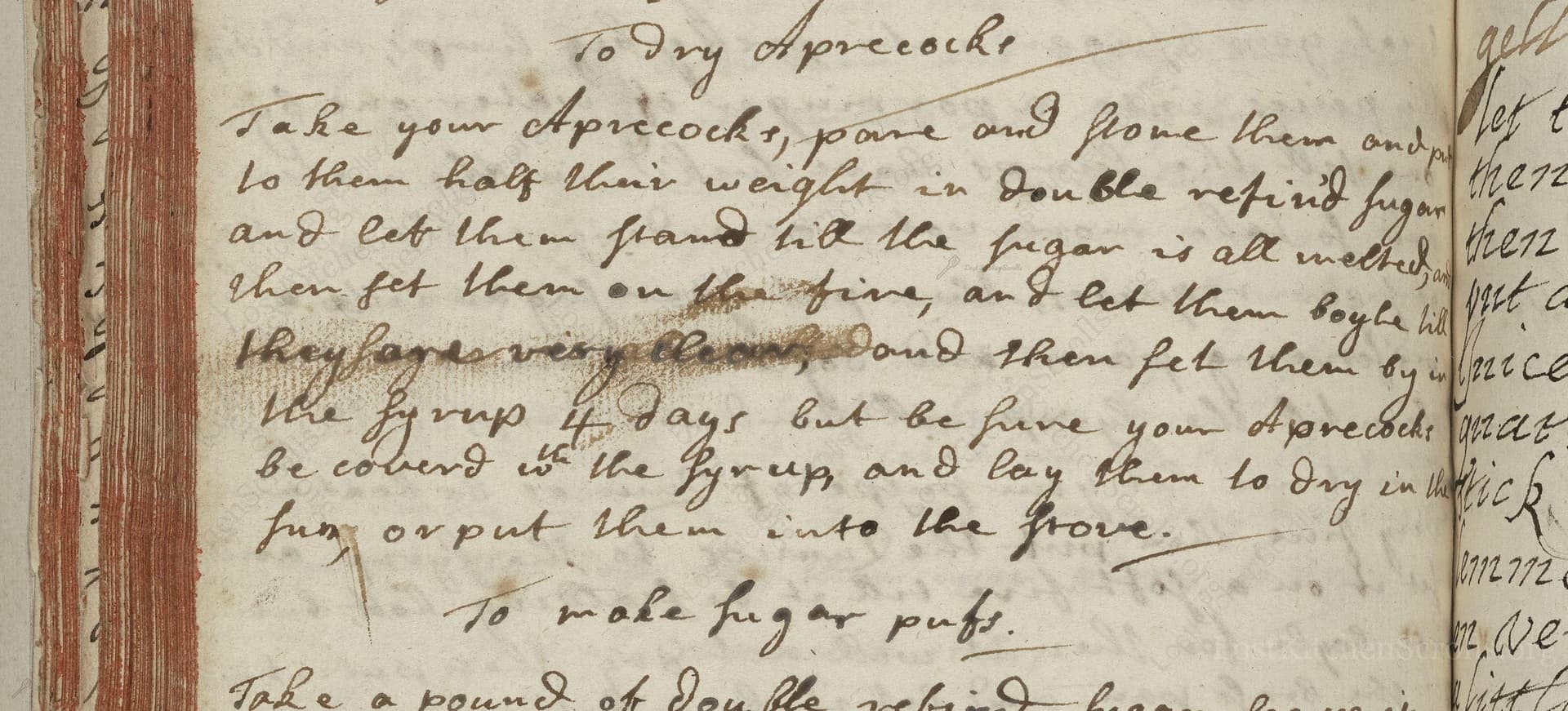To Dry Apreacocke
From the treasured pages of Cookbook of Constance Hall
Written by Constance Hall

To Dry Apreacocke
"Take your Apreacocks, pare and stone them, then way lo them half their weight in Double refin'd sugan, and let them stand till the sugar is all melted, and then set them on the fire, and let them Boyte till they lages very thick and then set them by in the syrup 4 days but be sure your Apreacocks be cover'd with the syrup, and lay them to dry in the sun or put them into the stove."
Note on the Original Text
The recipe is written without precise measurements or timing, reflecting a time when cooks relied on their senses and experience rather than rigid instructions. Ingredients like 'Double refin'd sugan' mean the finest, whitest sugar available, and 'Boyle till they lages very thick' refers to simmering until the syrup turns viscous. Old spellings such as 'Apreacocke' (apricot), and 'Boyle' (boil) are typical, with abbreviations and non-standard phrasing adding to the charm—and challenge—of interpreting historic manuscripts.

Title
Cookbook of Constance Hall (1672)
You can also click the book image above to peruse the original tome
Writer
Constance Hall
Era
1672
Publisher
Unknown
Background
A spirited foray into 17th-century kitchens, this collection by Constance Hall brims with the flavors, secrets, and delicacies of Restoration-era England—perfect for cooks keen to revive a dash of history in their modern menus.
Kindly made available by
Folger Shakespeare Library
This recipe hails from 1672, recorded by Constance Hall—a time when preserving fruit through candying and drying was both a culinary art and a necessity in English households. Sugar was a prized (and expensive) ingredient, reserved for delicacies and preserving seasonal bounty. Such recipes were often found in the handwritten household books of well-to-do families, reflecting both the availability of imported sugar and the increasing interest in elaborate sweetmeats for entertaining guests.

In the 17th century, apricots would be peeled with small knives and stoned by hand. The sugar and fruit would be mixed in large earthenware or pewter bowls, then boiled gently in broad shallow pans over a wood or coal fire. After soaking, the fruit was dried in wooden racks or on woven trays, either set in the sun outside or in a warm drying closet or 'stove'—an early heated room or chamber.
Prep Time
30 mins
Cook Time
30 mins
Servings
10
We've done our best to adapt this historical recipe for modern kitchens, but some details may still need refinement. We warmly welcome feedback from fellow cooks and culinary historians — your insights support the entire community!
Ingredients
- Fresh apricots (as desired; for example, 2 pounds)
- White granulated sugar (use half the weight of apricots; e.g., 1 pound for 2 pounds fruit)
Instructions
- To make these candied apricots the 17th-century way, start by peeling and removing the stones from fresh ripe apricots.
- Weigh your prepared fruit, then use an equal amount of white granulated sugar, at half the weight of the fruit.
- (For instance, if you have 2 pounds of apricots, use 1 pound of sugar.) Layer the apricots with the sugar in a bowl and let them sit until the sugar draws out fruit juices and dissolves, making a syrup.
- Then, gently cook everything over medium-low heat, stirring often, until the syrup thickens and the apricots become translucent and glossy.
- Let them soak and steep, fully immersed in this syrup, for 4 days to absorb flavor and preserve their form.
- After this rest, carefully spread the apricots onto a rack or parchment, and either lay them in the sun to dry or finish them in a low oven (about 175°F) until they become firm and leathery.
- Store your dried candied apricots in an airtight container.
Estimated Calories
120 per serving
Cooking Estimates
It takes about 30 minutes to prepare the apricots and layer them with sugar. Cooking on the stove takes 30 more minutes. The apricots soak in syrup for 4 days, but you do not need to watch them during that time. Drying will take another 4 hours in a low oven or sun. Each serving contains about 120 calories, and the recipe makes 10 servings.
As noted above, we have made our best effort to translate and adapt this historical recipe for modern kitchens, taking into account ingredients nowadays, cooking techniques, measurements, and so on. However, historical recipes often contain assumptions that require interpretation.
We'd love for anyone to help improve these adaptations. Community contributions are highly welcome. If you have suggestions, corrections, or cooking tips based on your experience with this recipe, please share them below.
Join the Discussion
Rate This Recipe
Dietary Preference
Main Ingredients

Den Bockfisch In Einer Fleisch Suppen Zu Kochen
This recipe hails from a German manuscript cookbook compiled in 1696, a time whe...

Die Grieß Nudlen Zumachen
This recipe comes from a rather mysterious manuscript cookbook, penned anonymous...

Ein Boudain
This recipe comes from an anonymous German-language manuscript cookbook from 169...

Ein Gesaltzen Citroni
This recipe, dating from 1696, comes from an extensive anonymous German cookbook...
Browse our complete collection of time-honored recipes



